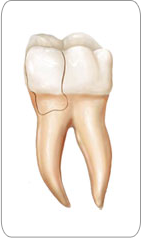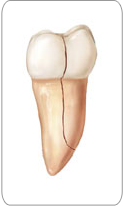Cracked Teeth
Cracked Teeth
Dentists are utilizing modern and complex procedures to ensure people have healthy teeth that last a long time. The need for proper and more advanced care of the teeth became necessary because of the way people’s lives are exposed to different levels of stress. These stress factors include tooth exposure to habits that encourage teeth cracking, such as biting/chewing on hard objects, teeth grinding/clenching etc.
What are the symptoms of a cracked tooth?
Generally, pain in various forms is the symptom of a cracked tooth. The pain could come when you are chewing, or with the exposure of the tooth to extreme temperatures (hot or cold). Often times, it may be hard for your dentist to pinpoint the exact location of the crack because this type of pain is erratic.
What makes a cracked tooth painful?
The knowledge of the anatomy of the tooth will help understand the reason for the pain you experience when you have a cracked tooth. There is a soft tissue deep inside the tooth known as pulp. This pulp is located beneath the enamel (white outer covering of a tooth), and the dentin (hard layer beneath the enamel). All the nerves, blood vessels, and connective tissues in a tooth are located within the pulp.
When the enamel or dentin is cracked, some of the loose pieces may irritate the pulp during chewing. The release of biting/chewing pressure closes the crack and creates sudden excruciating pain. This can happen several times while chewing. If the irritation is minimal, the pulp usually heals itself. However, if the irritation is consistent, and damages the pulp, the pulp will no longer be able to heal on its own. At this point pain comes not only from chewing, but also from sensitivity of the tooth to extreme temperature exposure. As the damage progresses, the pain increases and infection of the pulp tissue becomes very easy. This infection can affect the surrounding gum tissue and bone of the tooth.
The type of treatment and result you receive for your cracked tooth depends on the type of crack you have, its size, and its location. These are different types of cracks and their treatment options:
Craze Lines:
These are the very tiny and shallow cracks, which occur only on the outer enamel of the tooth. It is common in permanent teeth and painless too. The only concern is usually cosmetic.
Fractured Cusp:
A cusp is the pointed area of the tooth’s chewing surface. A weak cusp often cracks. This happens on the outer enamel and the cracked piece may fall off by itself, or your dentist will remove it. This often takes care of the pain and the tooth will receive a full crown restoration. Because there is no contact with the pulp, there is no need for a root canal procedure.
Cracked Tooth:
This crack starts from the chewing surface of the tooth and runs straight down to the root. Although the tooth does not break into two parts, the location of the crack makes pulp damage very common. Your dentist treats the damaged pulp with a root canal procedure. After the procedure, your dentist will then install a protective crown on the cracked tooth to hold the pieces firmly in place. However, the tooth will need an extraction if the crack reaches below the gum line. The picture shows a non-treatable tooth.
The importance of early detection cannot be over-emphasized. Cracks are so tiny that they often evade detection, even with custom lighting and high zooming. If a crack goes untreated, it will eventually worsen and deteriorate the tooth. This will eventually end in tooth loss. For a high chance of salvaging a cracked tooth, early detection and treatments are necessary.
Split Tooth:
When a crack goes untreated for a long time, the crack widens and splits the tooth into distinct parts, which can easily separate. You cannot salvage a split tooth as a whole. The possibility of saving any part of the tooth depends on the nature of the crack. If in a rare case, that it is possible to save any part of the tooth, your dentist will use a dental crown or any other appropriate restoration device to perform an endodontic procedure on the tooth.
Vertical Root Fracture:
This type of crack originates from the tooth root and extends upwards to the tooth’s outer enamel. Because it develops from the inside with often no visual indications or symptoms, vertical root fractur go undetected for some time. By the time detection is possible, the gum and surrounding bone of the tooth would have become diseased. Although it is possible to use an endodontic treatment to save any good portion of the tooth if any, the usual treatment option is extraction.
Will I get total healing for my cracked tooth after treatment?
Cracks in a tooth do not heal. The treatment procedures and the restoration devices strive to stop the crack from developing any further. Dental crowns help add some protection to the tooth but do not have 100 percent success rate. Even with these measures, some cracks continue to extend and eventually result in splits and loss of the tooth.
Make sure you discuss with your endodontist concerning your unique diagnosis and treatment options. This is because the type of treatment you use for your cracked tooth will determine its effectiveness in relieving your pain, and stopping the crack from extending. A treated cracked tooth usually functions well and you can chew with it painlessly for years. Your endodontist will educate you on ways of saving your teeth and maintain good dental health.
What precautions must I take to avoid teeth cracking?
Although you cannot totally avoid cracked teeth, there are some habits you should either form or stop so that your teeth will not be prone to easy cracking.
- Avoid grinding or clenching your teeth.
- Put on a mouth guard or any other suitable protective shield whenever you are involved in any contact sports.
- Avoid chewing or biting on hard objects such as nuts, ends of pens, unpopped corn, and ice.
- If you suffer from bruxism (teeth grinding during sleep), inform your dentist so that an appropriate customized mouth guard will be procured for you.
- Eat balanced diet and reduce your intake of snacks between meals.
- Floss your teeth once a day.
- Brush your teeth with fluoride toothpaste at least twice daily.
Dentkos Endodontics
16626 Pearl Rd
Strongsville, OH 44136
Contact
Phone: (440) 268-8445
Fax: 440 268 8443
Email: [email protected]






